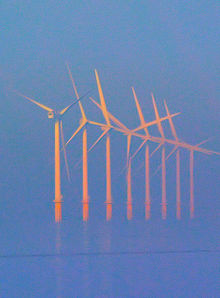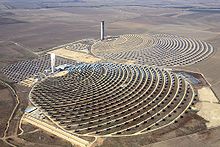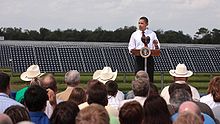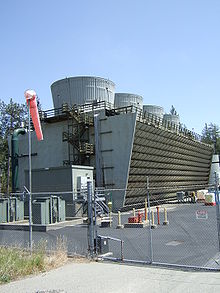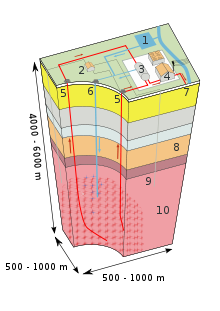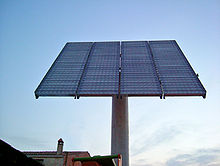- Renewable energy
-
Renewable energy Biofuel
Biomass
Geothermal
Hydroelectricity
Solar energy
Tidal power
Wave power
Wind powerRenewable energy is energy which comes from natural resources such as sunlight, wind, rain, tides, and geothermal heat, which are renewable (naturally replenished). About 16% of global final energy consumption comes from renewables, with 10% coming from traditional biomass, which is mainly used for heating, and 3.4% from hydroelectricity. New renewables (small hydro, modern biomass, wind, solar, geothermal, and biofuels) accounted for another 2.8% and are growing very rapidly.[1] The share of renewables in electricity generation is around 19%, with 16% of global electricity coming from hydroelectricity and 3% from new renewables.[2]
Wind power is growing at the rate of 30% annually, with a worldwide installed capacity of 198 gigawatts (GW) in 2010,[3][4] and is widely used in Europe, Asia, and the United States.[5] At the end of 2010, cumulative global photovoltaic (PV) installations surpassed 40 GW[6][7][8] and PV power stations are popular in Germany and Spain.[9] Solar thermal power stations operate in the USA and Spain, and the largest of these is the 354 megawatt (MW) SEGS power plant in the Mojave Desert.[10] The world's largest geothermal power installation is the Geysers in California, with a rated capacity of 750 MW. Brazil has one of the largest renewable energy programs in the world, involving production of ethanol fuel from sugar cane, and ethanol now provides 18% of the country's automotive fuel.[11] Ethanol fuel is also widely available in the USA.
While many renewable energy projects are large-scale, renewable technologies are also suited to rural and remote areas, where energy is often crucial in human development.[12] As of 2011, small solar PV systems provide electricity to a few million households, and micro-hydro configured into mini-grids serves many more. Over 44 million households use biogas made in household-scale digesters for lighting and/or cooking, and more than 166 million households rely on a new generation of more-efficient biomass cookstoves.[13] United Nations' Secretary-General Ban Ki-moon has said that renewable energy has the ability to lift the poorest nations to new levels of prosperity.[14]
Climate change concerns, coupled with high oil prices, peak oil, and increasing government support, are driving increasing renewable energy legislation, incentives and commercialization.[15] New government spending, regulation and policies helped the industry weather the global financial crisis better than many other sectors.[16] According to a 2011 projection by the International Energy Agency, solar power generators may produce most of the world’s electricity within 50 years, dramatically reducing the emissions of greenhouse gases that harm the environment.[17]
Contents
Overview
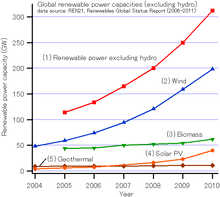 Global renewable power capacity excluding hydro[18]
Global renewable power capacity excluding hydro[18]
Renewable energy flows involve natural phenomena such as sunlight, wind, tides, plant growth, and geothermal heat, as the International Energy Agency explains:[19]
Renewable energy is derived from natural processes that are replenished constantly. In its various forms, it derives directly from the sun, or from heat generated deep within the earth. Included in the definition is electricity and heat generated from solar, wind, ocean, hydropower, biomass, geothermal resources, and biofuels and hydrogen derived from renewable resources.Renewable energy replaces conventional fuels in four distinct areas: power generation, hot water/ space heating, transport fuels, and rural (off-grid) energy services:[20]
- Power generation. Renewable energy provides 18 percent of total electricity generation worldwide. Renewable power generators are spread across many countries, and wind power alone already provides a significant share of electricity in some areas: for example, 14 percent in the U.S. state of Iowa, 40 percent in the northern German state of Schleswig-Holstein, and 20 percent in Denmark. Some countries get most of their power from renewables, including Iceland and Paraguay (100 percent), Norway (98 percent), Brazil (86 percent), Austria (62 percent), New Zealand (65 percent), and Sweden (54 percent).[21]
- Heating. Solar hot water makes an important contribution to renewable heat in many countries, most notably in China, which now has 70 percent of the global total (180 GWth). Most of these systems are installed on multi-family apartment buildings and meet a portion of the hot water needs of an estimated 50–60 million households in China. Worldwide, total installed solar water heating systems meet a portion of the water heating needs of over 70 million households. The use of biomass for heating continues to grow as well. In Sweden, national use of biomass energy has surpassed that of oil. Direct geothermal for heating is also growing rapidly.[21]
- Transport fuels. Renewable biofuels have contributed to a significant decline in oil consumption in the United States since 2006. The 93 billion liters of biofuels produced worldwide in 2009 displaced the equivalent of an estimated 68 billion liters of gasoline, equal to about 5 percent of world gasoline production.[21]
Mainstream forms of renewable energy
Wind power
Main article: Wind power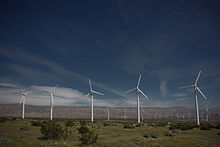 Wind Turbines located outside of Palm Springs, California
Wind Turbines located outside of Palm Springs, California
Airflows can be used to run wind turbines. Modern wind turbines range from around 600 kW to 5 MW of rated power, although turbines with rated output of 1.5–3 MW have become the most common for commercial use; the power output of a turbine is a function of the cube of the wind speed, so as wind speed increases, power output increases dramatically.[22] Areas where winds are stronger and more constant, such as offshore and high altitude sites, are preferred locations for wind farms. Typical capacity factors are 20-40%, with values at the upper end of the range in particularly favourable sites.[23][24]
Globally, the long-term technical potential of wind energy is believed to be five times total current global energy production, or 40 times current electricity demand. This could require wind turbines to be installed over large areas, particularly in areas of higher wind resources. Offshore resources experience mean wind speeds of ~90% greater than that of land, so offshore resources could contribute substantially more energy.[25]
Hydropower
See also: Hydroelectricity and Hydropower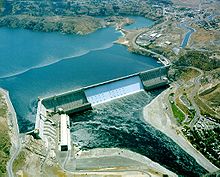 Grand Coulee Dam is a hydroelectric gravity dam on the Columbia River in the U.S. state of Washington. The dam supplies four power stations with an installed capacity of 6,809 MW and is the largest electric power-producing facility in the United States.
Grand Coulee Dam is a hydroelectric gravity dam on the Columbia River in the U.S. state of Washington. The dam supplies four power stations with an installed capacity of 6,809 MW and is the largest electric power-producing facility in the United States.
Energy in water can be harnessed and used. Since water is about 800 times denser than air, even a slow flowing stream of water, or moderate sea swell, can yield considerable amounts of energy. There are many forms of water energy:
- Hydroelectric energy is a term usually reserved for large-scale hydroelectric dams. Examples are the Grand Coulee Dam in Washington State and the Akosombo Dam in Ghana.
- Micro hydro systems are hydroelectric power installations that typically produce up to 100 kW of power. They are often used in water rich areas as a remote-area power supply (RAPS).
- Run-of-the-river hydroelectricity systems derive kinetic energy from rivers and oceans without using a dam.
Solar energy
See also: Solar energy, Solar power, and Solar thermal energy Monocrystalline solar cell.
Monocrystalline solar cell.
Solar energy is the energy derived from the sun through the form of solar radiation. Solar powered electrical generation relies on photovoltaics and heat engines. A partial list of other solar applications includes space heating and cooling through solar architecture, daylighting, solar hot water, solar cooking, and high temperature process heat for industrial purposes.
Solar technologies are broadly characterized as either passive solar or active solar depending on the way they capture, convert and distribute solar energy. Active solar techniques include the use of photovoltaic panels and solar thermal collectors to harness the energy. Passive solar techniques include orienting a building to the Sun, selecting materials with favorable thermal mass or light dispersing properties, and designing spaces that naturally circulate air.
Biomass
Biomass (plant material) is a renewable energy source because the energy it contains comes from the sun. Through the process of photosynthesis, plants capture the sun's energy. When the plants are burnt, they release the sun's energy they contain. In this way, biomass functions as a sort of natural battery for storing solar energy. As long as biomass is produced sustainably, with only as much used as is grown, the battery will last indefinitely.[26]
In general there are two main approaches to using plants for energy production: growing plants specifically for energy use, and using the residues from plants that are used for other things. The best approaches vary from region to region according to climate, soils and geography.[26]
Biofuel
Main article: Biofuel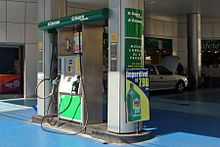 Brazil has bioethanol made from sugarcane available throughout the country. Shown a typical Petrobras gas station at São Paulo with dual fuel service, marked A for alcohol (ethanol) and G for gasoline.
Brazil has bioethanol made from sugarcane available throughout the country. Shown a typical Petrobras gas station at São Paulo with dual fuel service, marked A for alcohol (ethanol) and G for gasoline.
Biofuels include a wide range of fuels which are derived from biomass. The term covers solid biomass, liquid fuels and various biogases.[27] Liquid biofuels include bioalcohols, such as bioethanol, and oils, such as biodiesel. Gaseous biofuels include biogas, landfill gas and synthetic gas.
Bioethanol is an alcohol made by fermenting the sugar components of plant materials and it is made mostly from sugar and starch crops. With advanced technology being developed, cellulosic biomass, such as trees and grasses, are also used as feedstocks for ethanol production. Ethanol can be used as a fuel for vehicles in its pure form, but it is usually used as a gasoline additive to increase octane and improve vehicle emissions. Bioethanol is widely used in the USA and in Brazil.
Biodiesel is made from vegetable oils, animal fats or recycled greases. Biodiesel can be used as a fuel for vehicles in its pure form, but it is usually used as a diesel additive to reduce levels of particulates, carbon monoxide, and hydrocarbons from diesel-powered vehicles. Biodiesel is produced from oils or fats using transesterification and is the most common biofuel in Europe.
Biofuels provided 2.7% of the world's transport fuel in 2010.[28]
Geothermal energy
Main article: Geothermal energy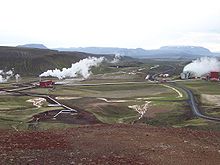 Krafla Geothermal Station in northeast Iceland
Krafla Geothermal Station in northeast Iceland
Geothermal energy is energy obtained by trapping the heat of the earth itself, both from kilometers deep into the Earth's crust in volcanically active locations of the globe or from shallow depths, as in geothermal heat pumps in most locations of the planet. It is expensive to build a power station but operating costs are low resulting in low energy costs for suitable sites. Ultimately, this energy derives from heat in the Earth's core.
Three types of power plants are used to generate power from geothermal energy: dry steam, flash, and binary. Dry steam plants take steam out of fractures in the ground and use it to directly drive a turbine that spins a generator. Flash plants take hot water, usually at temperatures over 200 °C, out of the ground, and allows it to boil as it rises to the surface then separates the steam phase in steam/water separators and then runs the steam through a turbine. In binary plants, the hot water flows through heat exchangers, boiling an organic fluid that spins the turbine. The condensed steam and remaining geothermal fluid from all three types of plants are injected back into the hot rock to pick up more heat.[citation needed]
The geothermal energy from the core of the Earth is closer to the surface in some areas than in others. Where hot underground steam or water can be tapped and brought to the surface it may be used to generate electricity. Such geothermal power sources exist in certain geologically unstable parts of the world such as Chile, Iceland, New Zealand, United States, the Philippines and Italy. The two most prominent areas for this in the United States are in the Yellowstone basin and in northern California. Iceland produced 170 MW geothermal power and heated 86% of all houses in the year 2000 through geothermal energy. Some 8000 MW of capacity is operational in total.[citation needed]
Renewable energy commercialization
Main article: Renewable energy commercializationGrowth of renewables
 Renewable power generation and capacity as a proportion of change in global power supply[29]
Renewable power generation and capacity as a proportion of change in global power supply[29]
During the five-years from the end of 2004 through 2009, worldwide renewable energy capacity grew at rates of 10–60 percent annually for many technologies. For wind power and many other renewable technologies, growth accelerated in 2009 relative to the previous four years.[20] More wind power capacity was added during 2009 than any other renewable technology. However, grid-connected PV increased the fastest of all renewables technologies, with a 60-percent annual average growth rate for the five-year period.[20] In 2010, renewable power consisted about a third of the newly built power generation capacities.[29]
Selected renewable energy indicators[4] Selected global indicators 2008 2009 2010 Investment in new renewable capacity (annual) 130 160 211 billion USD Renewables power capacity (existing) 1,140 1,230 1,320 GWe Hydropower capacity (existing) 950 980 1,010 GWe Wind power capacity (existing) 121 159 198 GWe Solar PV capacity (grid-connected) 16 23 40 GWe Solar hot water capacity (existing) 130 160 185 GWth Ethanol production (annual) 67 76 86 billion liters Countries with policy targets
for renewable energy use79 89 98 Scientists have advanced a plan to power 100% of the world's energy with wind, hydroelectric, and solar power by the year 2030.[30][31]
According to a 2011 projection by the International Energy Agency, solar power generators may produce most of the world’s electricity within 50 years, dramatically reducing the emissions of greenhouse gases that harm the environment. Cedric Philibert, senior analyst in the renewable energy division at the IEA said: “Photovoltaic and solar-thermal plants may meet most of the world’s demand for electricity by 2060 -- and half of all energy needs -- with wind, hydropower and biomass plants supplying much of the remaining generation”. “Photovoltaic and concentrated solar power together can become the major source of electricity,” Philibert said.[17]
Economic trends
All forms of energy are expensive, but as time progresses, renewable energy generally gets cheaper,[32][33] while fossil fuels generally get more expensive. Al Gore has explained that renewable energy technologies are declining in price for three main reasons:[34]
First, once the renewable infrastructure is built, the fuel is free. Unlike carbon-based fuels, the wind and the sun and the earth itself provide fuel that is free, in amounts that are effectively limitless.
Second, while fossil fuel technologies are more mature, renewable energy technologies are being rapidly improved. So innovation and ingenuity give us the ability to constantly increase the efficiency of renewable energy and continually reduce its cost.
Third, once the world makes a clear commitment to shifting toward renewable energy, the volume of production will itself sharply reduce the cost of each windmill and each solar panel, while adding yet more incentives for additional research and development to further speed up the innovation process.[34]
Wind power market
See also: List of onshore wind farms and List of offshore wind farms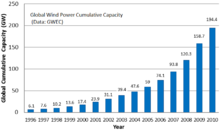 Wind power: worldwide installed capacity [35]
Wind power: worldwide installed capacity [35]
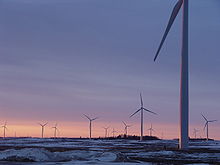 Fenton Wind Farm at sunrise
Fenton Wind Farm at sunrise
Global wind power installations increased by 35,800 MW in 2010, bringing total installed capacity up to 194,400 MW, a 22.5% increase on the 158,700 MW installed at the end of 2009. For the first time more than half of all new wind power was added outside of the traditional markets of Europe and North America, mainly driven, by the continuing boom in China which accounted for nearly half of all of the installations at 16,500 MW. China now has 42,300 MW of wind power installed.[36] Several countries have achieved relatively high levels of wind power penetration, such as 21% of stationary electricity production in Denmark,[37] 18% in Portugal,[37] 16% in Spain,[37] 14% in Ireland[38] and 9% in Germany in 2010.[28][37] As of 2011, 83 countries around the world are using wind power on a commercial basis.[28]
Top 10 wind power countries[39] Country Total capacity
end 2009 (MW)Total capacity
June 2010 (MW)United States 35,159 36,300 China 26,010 33,800 Germany 25,777 26,400 Spain 19,149 19,500 India 10, 925 12,100 Italy 4,850 5,300 France 4,521 5,000 United Kingdom 4,092 4,600 Portugal 3,535 3,800 Denmark 3,497 3,700 Rest of world 21,698 24,500 Total 159,213 175,000 As of November 2010, the Roscoe Wind Farm (781 MW) is the world's largest wind farm.[40] As of September 2010, the Thanet Offshore Wind Project in United Kingdom is the largest offshore wind farm in the world at 300 MW, followed by Horns Rev II (209 MW) in Denmark. The United Kingdom is the world's leading generator of offshore wind power, followed by Denmark.[41]
There are many large wind farms under construction and these include BARD Offshore 1 (400 MW), Greater Gabbard wind farm (500 MW), Lincs Wind Farm (270 MW), London Array (1000 MW), Lower Snake River Wind Project (343 MW), Macarthur Wind Farm (420 MW), Shepherds Flat Wind Farm (845 MW), Sheringham Shoal (317 MW), and the Walney Wind Farm (367 MW).
New generation of solar thermal plants
Main article: List of solar thermal power stationsSee also: Solar power plants in the Mojave DesertLarge solar thermal power stations include the 354 megawatt (MW) Solar Energy Generating Systems power plant in the USA, Solnova Solar Power Station (Spain, 150 MW), Andasol solar power station (Spain, 100 MW), Nevada Solar One (USA, 64 MW), PS20 solar power tower (Spain, 20 MW), and the PS10 solar power tower (Spain, 11 MW).
The Ivanpah Solar Power Facility is a 392 megawatt (MW) solar power facility which is under construction in south-eastern California.[42] The Solana Generating Station is a 280 MW solar power plant which is under construction near Gila Bend, Arizona, about 70 miles (110 km) southwest of Phoenix. The Crescent Dunes Solar Energy Project is a 110 megawatt (MW) solar thermal power project currently under construction near Tonopah, about 190 miles (310 km) northwest of Las Vegas.[43]
The solar thermal power industry is growing rapidly with 1.2 GW under construction as of April 2009 and another 13.9 GW announced globally through 2014. Spain is the epicenter of solar thermal power development with 22 projects for 1,037 MW under construction, all of which are projected to come online by the end of 2010.[44] In the United States, 5,600 MW of solar thermal power projects have been announced.[45] In developing countries, three World Bank projects for integrated solar thermal/combined-cycle gas-turbine power plants in Egypt, Mexico, and Morocco have been approved.[46]
Photovoltaic market
Main article: List of photovoltaic power stations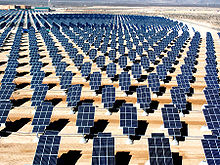 Nellis Solar Power Plant in the United States.
Nellis Solar Power Plant in the United States.
Solar photovoltaic cells convert sunlight into electricity and photovoltaic production has been increasing by an average of more than 20 percent each year since 2002, making it a fast-growing energy technology.[6][47] At the end of 2010, cumulative global photovoltaic (PV) installations surpassed 40 GW[6][7][8] and PV power stations are popular in Germany and Spain.[9]
Many solar photovoltaic power stations have been built, mainly in Europe.[48] As of October 2011, the largest photovoltaic (PV) power plants in the world are the Sarnia Photovoltaic Power Plant (Canada, 97 MW), Montalto di Castro Photovoltaic Power Station (Italy, 84.2 MW), Finsterwalde Solar Park (Germany, 80.7 MW), Lieberose Photovoltaic Park (Germany, 71.8 MW), Rovigo Photovoltaic Power Plant (Italy, 70 MW), Olmedilla Photovoltaic Park (Spain, 60 MW), and the Strasskirchen Solar Park (Germany, 54 MW).[48]
There are also many large plants under construction. The Desert Sunlight Project is a 550 MW solar power plant under construction in Riverside County, California, that will use thin-film solar photovoltaic modules made by First Solar.[49] The Blythe Solar Power Project is a 500 MW photovoltaic station under construction in Riverside County, California. The Agua Caliente Solar Project is a 290 megawatt photovoltaic solar generating facility being built in Yuma County, Arizona. The California Valley Solar Ranch (CVSR) is a 250 megawatt (MW) solar photovoltaic power plant, which is being built by SunPower in the Carrizo Plain, northeast of California Valley.[50] The 230 MW Antelope Valley Solar Ranch is a First Solar photovoltaic project which is under construction in the Antelope Valley area of the Western Mojave Desert, and due to be completed in 2013.[51] The Mesquite Solar project is a photovoltaic solar power plant being built in Arlington, Maricopa County, Arizona, owned by Sempra Generation.[52] Phase 1 will have a nameplate capacity of 150 megawatts.[53]
Many of these plants are integrated with agriculture and some use innovative tracking systems that follow the sun's daily path across the sky to generate more electricity than conventional fixed-mounted systems. There are no fuel costs or emissions during operation of the power stations.
However, when it comes to renewable energy systems and PV, it is not just large systems that matter. Building-integrated photovoltaics or "onsite" PV systems use existing land and structures and generate power close to where it is consumed.[54]
Biofuels for transportation
See also: Ethanol fuel and BioEthanol for Sustainable TransportBiofuels provided 2.7% of the world's transport fuel in 2010.[28] Mandates for blending biofuels exist in 31 countries at the national level and in 29 states/provinces.[28] According to the International Energy Agency, biofuels have the potential to meet more than a quarter of world demand for transportation fuels by 2050.[55]
Since the 1970s, Brazil has had an ethanol fuel program which has allowed the country to become the world's second largest producer of ethanol (after the United States) and the world's largest exporter.[56] Brazil’s ethanol fuel program uses modern equipment and cheap sugar cane as feedstock, and the residual cane-waste (bagasse) is used to produce heat and power.[57] There are no longer light vehicles in Brazil running on pure gasoline. By the end of 2008 there were 35,000 filling stations throughout Brazil with at least one ethanol pump.[58]
Nearly all the gasoline sold in the United States today is mixed with 10 percent ethanol, a mix known as E10,[59] and motor vehicle manufacturers already produce vehicles designed to run on much higher ethanol blends. Ford, DaimlerChrysler, and GM are among the automobile companies that sell “flexible-fuel” cars, trucks, and minivans that can use gasoline and ethanol blends ranging from pure gasoline up to 85% ethanol (E85). By mid-2006, there were approximately 6 million E85-compatible vehicles on U.S. roads.[60] The challenge is to expand the market for biofuels beyond the farm states where they have been most popular to date. Flex-fuel vehicles are assisting in this transition because they allow drivers to choose different fuels based on price and availability. The Energy Policy Act of 2005, which calls for 7.5 billion US gallons (28,000,000 m3) of biofuels to be used annually by 2012, will also help to expand the market.[60]
Geothermal energy commercialization
See also: Geothermal energy in the United StatesThe International Geothermal Association (IGA) has reported that 10,715 megawatts (MW) of geothermal power in 24 countries is online, which is expected to generate 67,246 GWh of electricity in 2010.[61] This represents a 20% increase in geothermal power online capacity since 2005. IGA projects this will grow to 18,500 MW by 2015, due to the large number of projects presently under consideration, often in areas previously assumed to have little exploitable resource.[61]
In 2010, the United States led the world in geothermal electricity production with 3,086 MW of installed capacity from 77 power plants;[62] the largest group of geothermal power plants in the world is located at The Geysers, a geothermal field in California.[63] The Philippines follows the US as the second highest producer of geothermal power in the world, with 1,904 MW of capacity online; geothermal power makes up approximately 18% of the country's electricity generation.[62]
Geothermal (ground source) heat pumps represented an estimated 30 GWth of installed capacity at the end of 2008, with other direct uses of geothermal heat (i.e., for space heating, agricultural drying and other uses) reaching an estimated 15 GWth. As of 2008, at least 76 countries use direct geothermal energy in some form.
Developing country markets
Main article: Renewable energy in developing countries Solar cookers use sunlight as energy source for outdoor cooking.
Solar cookers use sunlight as energy source for outdoor cooking.
Renewable energy can be particularly suitable for developing countries. In rural and remote areas, transmission and distribution of energy generated from fossil fuels can be difficult and expensive. Producing renewable energy locally can offer a viable alternative.[64]
As of 2011, small solar PV systems provide electricity to a few million households, and micro-hydro configured into mini-grids serves many more. Over 44 million households use biogas made in household-scale digesters for lighting and/or cooking, and more than 166 million households rely on a new generation of more-efficient biomass cookstoves.[13]
Kenya is the world leader in the number of solar power systems installed per capita. More than 30,000 very small solar panels, each producing 12 to 30 watts, are sold in Kenya annually.[65]
Renewable energy projects in many developing countries have demonstrated that renewable energy can directly contribute to poverty alleviation by providing the energy needed for creating businesses and employment. Renewable energy technologies can also make indirect contributions to alleviating poverty by providing energy for cooking, space heating, and lighting. Renewable energy can also contribute to education, by providing electricity to schools.[66]
Industry and policy trends
See also: Renewable energy industry and Renewable energy policy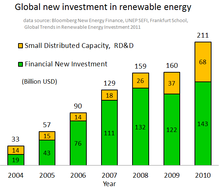 Global New Investments in Renewable Energy[67]
Global New Investments in Renewable Energy[67]
U.S. President Barack Obama's American Recovery and Reinvestment Act of 2009 includes more than $70 billion in direct spending and tax credits for clean energy and associated transportation programs. Clean Edge suggests that the commercialization of clean energy will help countries around the world pull out of the current economic malaise.[16] Leading renewable energy companies include First Solar, Gamesa, GE Energy, Q-Cells, Sharp Solar, Siemens, SunOpta, Suntech, and Vestas.[68]
The International Renewable Energy Agency (IRENA) is an intergovernmental organization for promoting the adoption of renewable energy worldwide. It aims to provide concrete policy advice and facilitate capacity building and technology transfer. IRENA was formed on January 26, 2009, by 75 countries signing the charter of IRENA.[69] As of March 2010, IRENA has 143 member states who all are considered as founding members, of which 14 have also ratified the statute.[70]
As of 2011, 119 countries have some form of national renewable energy policy target or renewable support policy. National targets now exist in at least 98 countries. There is also a wide range of policies at state/provincial and local levels.[28]
United Nations' Secretary-General Ban Ki-moon has said that renewable energy has the ability to lift the poorest nations to new levels of prosperity.[14] In October 2011, he "announced the creation of a high-level group to drum up support for energy access, energy efficiency and greater use of renewable energy. The group is to be co-chaired by Kandeh Yumkella, the chair of UN Energy and director general of the UN Industrial Development Organisation, and Charles Holliday, chairman of Bank of America".[71]
New and emerging renewable energy technologies
New and emerging renewable energy technologies are still under development and include cellulosic ethanol, hot-dry-rock geothermal power, and ocean energy.[72] These technologies are not yet widely demonstrated or have limited commercialization. Many are on the horizon and may have potential comparable to other renewable energy technologies, but still depend on attracting sufficient attention and research, development and demonstration (RD&D) funding.[72]
Cellulosic ethanol
See also: Cellulosic ethanol commercializationCompanies such as Iogen, Broin, and Abengoa are building refineries that can process biomass and turn it into ethanol, while companies such as Diversa, Novozymes, and Dyadic are producing enzymes which could enable a cellulosic ethanol future. The shift from food crop feedstocks to waste residues and native grasses offers significant opportunities for a range of players, from farmers to biotechnology firms, and from project developers to investors.[73]
Selected Commercial Cellulosic Ethanol Plants in the U.S.[74][75]
(Operational or under construction)Company Location Feedstock Abengoa Bioenergy Hugoton, KS Wheat straw BlueFire Ethanol Irvine, CA Multiple sources Gulf Coast Energy Mossy Head, FL Wood waste Mascoma Lansing, MI Wood POET LLC Emmetsburg, IA Corn cobs SunOpta Little Falls, MN Wood chips Xethanol Auburndale, FL Citrus peels Ocean energy
Systems to harvest utility-scale electrical power from ocean waves have recently been gaining momentum as a viable technology. The potential for this technology is considered promising, especially on west-facing coasts with latitudes between 40 and 60 degrees:[76]
In the United Kingdom, for example, the Carbon Trust recently estimated the extent of the economically viable offshore resource at 55 TWh per year, about 14% of current national demand. Across Europe, the technologically achievable resource has been estimated to be at least 280 TWh per year. In 2003, the U.S. Electric Power Research Institute (EPRI) estimated the viable resource in the United States at 255 TWh per year (6% of demand).[76]
Funding for a wave farm in Scotland was announced in February, 2007 by the Scottish Government, at a cost of over 4 million pounds, as part of a UK£13 million funding packages for ocean power in Scotland. The farm will be the world's largest with a capacity of 3MW generated by four Pelamis machines.[77]
The world's first commercial tidal stream generator was installed in 2007 in the narrows of Strangford Lough in Ireland. The 1.2 megawatt underwater tidal electricity generator, part of Northern Ireland's Environment & Renewable Energy Fund scheme, takes advantage of the fast tidal flow (up to 4 metres per second) in the lough. Although the generator is powerful enough to power a thousand homes, the turbine has minimal environmental impact, as it is almost entirely submerged, and the rotors pose no danger to wildlife as they turn quite slowly.[78]
Ocean thermal energy conversion (OTEC) uses the temperature difference that exists between deep and shallow waters to run a heat engine.
Enhanced Geothermal Systems
Main article: Enhanced Geothermal SystemsEnhanced Geothermal Systems are a new type of geothermal power technologies that do not require natural convective hydrothermal resources. The vast majority of geothermal energy within drilling reach is in dry and non-porous rock.[79] EGS technologies "enhance" and/or create geothermal resources in this "hot dry rock (HDR)" through hydraulic stimulation.
EGS / HDR technologies, like hydrothermal geothermal, are expected to be baseload resources which produce power 24 hours a day like a fossil plant. Distinct from hydrothermal, HDR / EGS may be feasible anywhere in the world, depending on the economic limits of drill depth. Good locations are over deep granite covered by a thick (3–5 km) layer of insulating sediments which slow heat loss.[80]
There are HDR and EGS systems currently being developed and tested in France, Australia, Japan, Germany, the U.S. and Switzerland. The largest EGS project in the world is a 25 megawatt demonstration plant currently being developed in the Cooper Basin, Australia. The Cooper Basin has the potential to generate 5,000–10,000 MW.
Experimental solar power
See also: Solar Power#Experimental solar powerConcentrated photovoltaics (CPV) systems employ sunlight concentrated onto photovoltaic surfaces for the purpose of electrical power production. Thermoelectric, or "thermovoltaic" devices convert a temperature difference between dissimilar materials into an electric current. Space-based solar power is a theoretical design for the collection of solar power in space, for use on Earth.
Artificial photosynthesis
Artificial photosynthesis uses techniques include nanotechnology to store solar electromagnetic energy in chemical bonds by splitting water to produce hydrogen and then using carbon dioxide to make methanol.[81]
Renewable energy debate
Main article: Renewable energy debateRenewable electricity production, from sources such as wind power and solar power, is sometimes criticized for being variable or intermittent. However, the International Energy Agency has stated that deployment of renewable technologies usually increases the diversity of electricity sources and, through local generation, contributes to the flexibility of the system and its resistance to central shocks.[82]
There have been "not in my back yard" (NIMBY) concerns relating to the visual and other impacts of some wind farms, with local residents sometimes fighting or blocking construction.[83] In the USA, the Massachusetts Cape Wind project was delayed for years partly because of aesthetic concerns. However, residents in other areas have been more positive and there are many examples of community wind farm developments. According to a town councilor, the overwhelming majority of locals believe that the Ardrossan Wind Farm in Scotland has enhanced the area.[84]
The market for renewable energy technologies has continued to grow. Climate change concerns, coupled with high oil prices, peak oil, and increasing government support, are driving increasing renewable energy legislation, incentives and commercialization.[15] New government spending, regulation and policies helped the industry weather the 2009 economic crisis better than many other sectors.[16]
See also
- Lists about renewable energy
- Sustainable energy
References
- ^ REN21 (2011). "Renewables 2011: Global Status Report". p. 17. http://www.ren21.net/Portals/97/documents/GSR/GSR2011_Master18.pdf.
- ^ REN21 (2011). "Renewables 2011: Global Status Report". p. 18. http://www.ren21.net/Portals/97/documents/GSR/GSR2011_Master18.pdf.
- ^ Lars Kroldrup. Gains in Global Wind Capacity Reported Green Inc., February 15, 2010.
- ^ a b REN21 (2011). "Renewables 2011: Global Status Report". p. 15. http://www.ren21.net/Portals/97/documents/GSR/GSR2011_Master18.pdf.
- ^ Global wind energy markets continue to boom – 2006 another record year (PDF).
- ^ a b c James Russell. Record Growth in Photovoltaic Capacity and Momentum Builds for Concentrating Solar Power Vital Signs, June 3, 2010.
- ^ a b REN21 (2009). Renewables Global Status Report: 2009 Update p. 12.
- ^ a b REN21 (2009). Renewables Global Status Report: 2009 Update p. 15.
- ^ a b World's largest photovoltaic power plants[dead link]
- ^ Solar Trough Power Plants (PDF).
- ^ "America and Brazil Intersect on Ethanol". Renewableenergyaccess.com. http://www.renewableenergyaccess.com/rea/news/story?id=44896. Retrieved 2011-11-21.
- ^ World Energy Assessment (2001). Renewable energy technologies, p. 221.
- ^ a b REN21 (2011). "Renewables 2011: Global Status Report". p. 14. http://www.ren21.net/Portals/97/documents/GSR/GSR2011_Master18.pdf.
- ^ a b Steve Leone (25 August 2011). "U.N. Secretary-General: Renewables Can End Energy Poverty". Renewable Energy World. http://www.renewableenergyworld.com/rea/news/article/2011/08/u-n-secretary-general-renewables-can-end-energy-poverty?cmpid=WNL-Friday-August26-2011.
- ^ a b United Nations Environment Programme Global Trends in Sustainable Energy Investment 2007: Analysis of Trends and Issues in the Financing of Renewable Energy and Energy Efficiency in OECD and Developing Countries (PDF), p. 3.
- ^ a b c Clean Edge (2009). Clean Energy Trends 2009 pp. 1-4.
- ^ a b Ben Sills (Aug 29, 2011). "Solar May Produce Most of World’s Power by 2060, IEA Says". Bloomberg. http://www.bloomberg.com/news/2011-08-29/solar-may-produce-most-of-world-s-power-by-2060-iea-says.html.
- ^ "REN21, Renewables Global Status Report (2006 - 2011)". Ren21.net. http://www.ren21.net/REN21Activities/Publications/GlobalStatusReport/tabid/5434/Default.aspx. Retrieved 2011-11-21.
- ^ IEA Renewable Energy Working Party (2002). Renewable Energy... into the mainstream, p. 9.
- ^ a b c REN21 (2010). Renewables 2010 Global Status Report p. 15.
- ^ a b c REN21 (2010). Renewables 2010 Global Status Report p. 53.
- ^ EWEA Executive summary "Analysis of Wind Energy in the EU-25" (PDF). European Wind Energy Association. http://www.ewea.org/fileadmin/ewea_documents/documents/publications/WETF/Facts_Summary.pdf EWEA Executive summary. Retrieved 2007-03-11.
- ^ How Does A Wind Turbine's Energy Production Differ from Its Power Production?[dead link]
- ^ Wind Power: Capacity Factor, Intermittency, and what happens when the wind doesn’t blow?. Retrieved 24 January 2008.
- ^ "Offshore stations experience mean wind speeds at 80 m that are 90% greater than over land on average. Evaluation of global wind power
"Overall, the researchers calculated winds at 80 meters [300 feet] traveled over the ocean at approximately 8.6 meters per second and at nearly 4.5 meters per second over land [20 and 10 miles per hour, respectively]." Global Wind Map Shows Best Wind Farm Locations . Retrieved January 30, 2006. - ^ a b Union of Concerned Scientists. How Biomass Energy Works
- ^ Demirbas, A. . (2009). "Political, economic and environmental impacts of biofuels: A review". Applied Energy 86: S108–S117. doi:10.1016/j.apenergy.2009.04.036.
- ^ a b c d e f REN21 (2011). "Renewables 2011: Global Status Report". pp. 13–14. http://www.ren21.net/Portals/97/documents/GSR/GSR2011_Master18.pdf.
- ^ a b UNEP, Bloomberg, Frankfurt School, Global Trends in Renewable Energy Investment 2011、Figure 24.
- ^ Jacobson, Mark Z.; Delucchi, M.A. (November 2009). "A Path to Sustainable Energy by 2030" (PDF). Scientific American 301 (5): 58–65. doi:10.1038/scientificamerican1109-58. PMID 19873905. http://www.stanford.edu/group/efmh/jacobson/Articles/I/sad1109Jaco5p.indd.pdf.
- ^ Mark Z. Jacobson and Mark A. Delucchi (30 December 2010). "Providing all global energy with wind, water, and solar power, Part I: Technologies, energy resources, quantities and areas of infrastructure, and materials". Energy Policy. Elsevier Ltd. http://www.sciencedirect.com/science?_ob=ArticleURL&_udi=B6V2W-51TXP82-2&_user=10&_coverDate=12%2F30%2F2010&_rdoc=1&_fmt=high&_orig=search&_origin=search&_sort=d&_docanchor=&view=c&_searchStrId=1626205720&_rerunOrigin=google&_acct=C000050221&_version=1&_urlVersion=0&_userid=10&md5=9447d10d53901259587cc5393eab802f&searchtype=a.
- ^ Renewable energy costs drop in '09 Reuters, November 23, 2009.
- ^ Solar Power 50% Cheaper By Year End - Analysis Reuters, November 24, 2009.
- ^ a b Al Gore (2009). Our Choice, Bloomsbury, p. 58.
- ^ "GWEC, Global Wind Report Annual Market Update". Gwec.net. http://www.gwec.net/index.php?id=180. Retrieved 2011-11-21.
- ^ David Beattie (18 March 2011). "Wind Power: China Picks Up Pace". Renewable Energy World. http://www.renewableenergyworld.com/rea/news/article/2011/03/wind-power-china-picks-up-paceeu-and-us-fall-but-global-market-grows?cmpid=WindNL-Thursday-March24-2011.
- ^ a b c d "World Wind Energy Report 2010" (PDF). Report. World Wind Energy Association. February 2011. http://www.wwindea.org/home/images/stories/pdfs/worldwindenergyreport2010_s.pdf. Retrieved 30-April-2011.
- ^ "Renewables". eirgrid.com. http://www.eirgrid.com/renewables/. Retrieved 22 November 2010.
- ^ Wald, Matthew L. (January 11, 2011). "China’s Galloping Wind Market". The New York Times. http://green.blogs.nytimes.com/2011/01/11/chinas-galloping-wind-market/?partner=rss&emc=rss.
- ^ E.ON wraps up 457 MW wind farm, transfers assets[dead link]
- ^ Patrick Barkham. "Blown away". Guardian. http://www.guardian.co.uk/environment/2009/jan/08/wind-power. Retrieved 2011-11-21.
- ^ Steven Mufson. Solar power project in Mojave Desert gets $1.4 billion boost from stimulus funds Washington Post, February 23, 2010.
- ^ "DOE Finalizes $737 Million Loan Guarantee to Tonopah Solar Energy for Nevada Project" (Press release). Loan Programs Office (LPO), Dept. of Energy (DOE). September 28, 2011. https://lpo.energy.gov/?p=5246. Retrieved 29 September 2011.
- ^ "Global Concentrated Solar Power Industry to Reach 25 GW by 2020". Renewableenergyworld.com. http://www.renewableenergyworld.com/rea/news/article/2009/05/global-concentrated-solar-power-industry-to-reach-25-gw-by-2020?cmpid=WNL-Friday-May8-2009. Retrieved 2011-11-21.
- ^ "Solar Thermal Projects Under Review or Announced". Energy.ca.gov. http://www.energy.ca.gov/siting/solar/index.html. Retrieved 2011-11-21.
- ^ REN21 (2008). Renewables 2007 Global Status Report (PDF) p. 12.
- ^ "Solar Expected to Maintain its Status as the World's Fastest-Growing Energy Technology". Socialfunds.com. 2009-03-03. http://www.socialfunds.com/news/article.cgi/2639.html. Retrieved 2011-11-21.
- ^ a b Denis Lenardic. Large-scale photovoltaic power plants ranking 1 - 50 PVresources.com, 2010.
- ^ "DOE Closes on Four Major Solar Projects". Renewable Energy World. 30 September 2011. http://www.renewableenergyworld.com/rea/news/article/2011/09/doe-closes-on-three-major-solar-projects?cmpid=SolarNL-Tuesday-October4-2011.
- ^ "NRG Energy Completes Acquisition of 250-Megawatt California Valley Solar Ranch from SunPower". MarketWatch. 30 September 2011. http://www.marketwatch.com/story/nrg-energy-completes-acquisition-of-250-megawatt-california-valley-solar-ranch-from-sunpower-2011-09-30.
- ^ "Exelon purchases 230 MW Antelope Valley Solar Ranch One from First Solar". Solar Server. 4 October 2011. http://www.solarserver.com/solar-magazine/solar-news/current/2011/kw40/exelon-purchases-230-mw-antelope-valley-solar-ranch-one-from-first-solar.html.
- ^ "Sempra Generation contracts with PG&E for 150 mw of solar power". Sempra Energy. October 12, 2010. http://public.sempra.com/newsreleases/viewpr.cfm?PR_ID=2536&Co_Short_Nm=SE. Retrieved 2011-02-06.
- ^ "Mesquite Solar". Sempra Generation. http://www.semprageneration.com/mesquite_solar.htm. Retrieved 2011-02-06.
- ^ Solar Integrated in New Jersey.
- ^ "IEA says biofuels can displace 27% of transportation fuels by 2050 Washington". Platts. 20 April 2011. http://www.platts.com/RSSFeedDetailedNews/RSSFeed/Oil/6017103.
- ^ "Industry Statistics: Annual World Ethanol Production by Country". Renewable Fuels Association. Archived from the original on 2008-04-08. http://web.archive.org/web/20080408091334/http://www.ethanolrfa.org/industry/statistics/#E. Retrieved 2008-05-02.
- ^ Macedo Isaias, M. Lima Verde Leal and J. Azevedo Ramos da Silva (2004). "Assessment of greenhouse gas emissions in the production and use of fuel ethanol in Brazil" (PDF). Secretariat of the Environment, Government of the State of São Paulo. Archived from the original on 2008-05-28. http://web.archive.org/web/20080528051443/http://www.eners.ch/plateforme/medias/macedo_2004.pdf. Retrieved 2008-05-09.
- ^ Daniel Budny and Paulo Sotero, editor (2007-04). "Brazil Institute Special Report: The Global Dynamics of Biofuels" (PDF). Brazil Institute of the Woodrow Wilson Center. http://www.wilsoncenter.org/topics/pubs/Brazil_SR_e3.pdf. Retrieved 2008-05-03.
- ^ Erica Gies. As Ethanol Booms, Critics Warn of Environmental Effect The New York Times, June 24, 2010.
- ^ a b "American Energy: The Renewable Path to Energy Security" (PDF). Worldwatch Institute. September 2006. http://images1.americanprogress.org/il80web20037/americanenergynow/AmericanEnergy.pdf. Retrieved 2007-03-11.
- ^ a b Geothermal Energy Association. Geothermal Energy: International Market Update May 2010, p. 4-6.
- ^ a b Geothermal Energy Association. Geothermal Energy: International Market Update May 2010, p. 7.
- ^ Khan, M. Ali (2007). "The Geysers Geothermal Field, an Injection Success Story" (PDF). http://www.gwpc.org/meetings/forum/2007/proceedings/Papers/Khan,%20Ali%20Paper.pdf. Retrieved 2010-01-25
- ^ Power for the People p. 3.
- ^ "The Rise of Renewable Energy" (PDF). http://rael.berkeley.edu/files/2006/Kammen-SciAm-Renewables-9-06.pdf. Retrieved 2011-11-21.
- ^ Energy for Development: The Potential Role of Renewable Energy in Meeting the Millennium Development Goals pp. 7-9.
- ^ "Bloomberg New Energy Finance, UNEP SEFI, Frankfurt School, Global Trends in Renewable Energy Investment 2011". Unep.org. http://www.unep.org/Renewable_Energy_Investment/. Retrieved 2011-11-21.
- ^ REN21 (2008). Renewables 2007 Global Status Report (PDF) p. 18.
- ^ [1][dead link]
- ^ [2][dead link]
- ^ Mark Tran (2 November 2011). "UN calls for universal access to renewable energy". The Guardian. http://www.guardian.co.uk/global-development/2011/nov/02/human-development-report-renewable-energy.
- ^ a b International Energy Agency (2007). Renewables in global energy supply: An IEA facts sheet (PDF), OECD, p. 3.
- ^ Pernick, Ron and Wilder, Clint (2007). The Clean Tech Revolution p. 96.
- ^ Decker, Jeff. Going Against the Grain: Ethanol from Lignocellulosics, Renewable Energy World, January 22, 2009.
- ^ "Building Cellulose" (PDF). http://www.grainnet.com/pdf/cellulosemap.pdf. Retrieved 2011-11-21.
- ^ a b Jeff Scruggs and Paul Jacob. Harvesting Ocean Wave Energy, Science, Vol. 323, 27 February 2009, p. 1176.
- ^ Orkney to get 'biggest' wave farm.
- ^ World tidal energy first for NI, BBC News BBC News, 7 June 2007.
- ^ Duchane, Dave; Brown, Don (December 2002). "Hot Dry Rock (HDR) Geothermal Energy Research and Development at Fenton Hill, New Mexico". Geo-Heat Centre Quarterly Bulletin (Klamath Falls, Oregon: Oregon Institute of Technology) 23 (4): pp. 13–19. ISSN 0276-1084. http://geoheat.oit.edu/bulletin/bull23-4/art4.pdf. Retrieved 2009-05-05
- ^ 20 slide presentation inc geothermal maps of Australia[dead link]
- ^ Collings AF and Critchley C (eds). Artificial Photosynthesis- From Basic Biology to Industrial Application (Wiley-VCH Weinheim 2005) p ix.
- ^ International Energy Agency (2007). Contribution of Renewables to Energy Security IEA Information Paper, p. 5.
- ^ "Whatever Happened to Wind Energy?". LiveScience. 2008-01-14. http://www.livescience.com/environment/080114-wind-energy.html. Retrieved 2011-11-21.
- ^ Simon Gourlay. "Wind farms are not only beautiful, they're absolutely necessary". Guardian. http://www.guardian.co.uk/commentisfree/2008/aug/12/windpower.alternativeenergy. Retrieved 2011-11-21.
Bibliography
- Aitken, Donald W. (2010). Transitioning to a Renewable Energy Future, International Solar Energy Society, January, 54 pages.
- HM Treasury (2006). Stern Review on the Economics of Climate Change, 575 pages.
- International Council for Science (c2006). Discussion Paper by the Scientific and Technological Community for the 14th session of the United Nations Commission on Sustainable Development, 17 pages.
- International Energy Agency (2006). World Energy Outlook 2006: Summary and Conclusions, OECD, 11 pages.
- International Energy Agency (2007). Renewables in global energy supply: An IEA facts sheet, OECD, 34 pages.
- International Energy Agency (2008). Deploying Renewables: Principles for Effective Policies, OECD, 8 pages.
- Makower, Joel, and Ron Pernick and Clint Wilder (2009). Clean Energy Trends 2009, Clean Edge.
- National Renewable Energy Laboratory (2006). Non-technical Barriers to Solar Energy Use: Review of Recent Literature, Technical Report, NREL/TP-520-40116, September, 30 pages.
- REN21 (2008). Renewables 2007 Global Status Report, Paris: REN21 Secretariat, 51 pages.
- REN21 (2009). Renewables Global Status Report: 2009 Update, Paris: REN21 Secretariat.
- REN21 (2010). Renewables 2010 Global Status Report, Paris: REN21 Secretariat, 78 pages.
- United Nations Environment Programme and New Energy Finance Ltd. (2007). Global Trends in Sustainable Energy Investment 2007: Analysis of Trends and Issues in the Financing of Renewable Energy and Energy Efficiency in OECD and Developing Countries, 52 pages.
- Worldwatch Institute and Center for American Progress (2006). American energy: The renewable path to energy security, 40 pages.
Renewable energy by country Wind by regionby countrySolar by regionAsia · Europe (EU)Australia · Canada · China · Germany · Greece · India · Israel · Italy · Japan · Morocco · Pakistan · Portugal · Romania · Spain · Turkey · United Kingdom · United StatesGeothermal by countryAustralia · Canada · Chile · China · Denmark · Germany · Iceland · Indonesia · Japan · Kenya · Mexico · New Zealand · Philippines · Portugal · Romania · Russia · Turkey · United Kingdom · United States · West IndiesTopics related to environmental technology 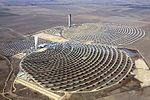
Pollution Industrial ecology · Solid waste treatment · Waste management · Air pollution (control · dispersion modeling) · Water (Wastewater treatment · Agricultural wastewater treatment · Industrial wastewater treatment · Sewage treatment · Water purification)Renewable energy Alternative energy · Energy development · Energy recovery · Energy efficiency · Renewable energy (development) · Sustainable energy · Fuel (Alternative fuel · Biofuel · Hydrogen technologies) · Transportation (Electric vehicle · Hybrid vehicle)Conservation Birth control · Permaculture · Conservation ethic · Recycling · Ecoforestry · Conservation biology · Environmental preservation · Remediation · Green computing · Building (Green · Natural · Sustainable architecture)Technology Applied science - Archaeology
- Artificial intelligence
- Ceramic
- Computing
- Cryogenics
- Electronics
- Energy
- Energy storage
- Engineering geology
- Engineering physics
- Environmental engineering science
- Environmental technology
- Fisheries science
- Hydraulics
- Management
- Materials science
- Microtechnology
- Nanotechnology
- Nuclear technology
- Particle physics
- Technician
- Technologist
- Zoography
Biomedical Domestic Educational Engineering - Acoustical
- Agricultural
- Architectural
- Audio
- Biochemical
- Biological
- Broadcast
- Building services
- Chemical
- Civil
- Construction
- Control
- Electrical
- Electronic
- Enterprise
- Entertainment
- Facade
- Fire protection
- Geotechnical
- Hydraulic
- Mechanical
- Mechatronics
- Nuclear
- Offshore
- Ontology
- Optical
- Petroleum
- Protein
- Radio Frequency
- Safety
- Structural
- Systems
Environmental - Ecological design
- Ecological engineering
- Ecotechnology
- Environmental engineering
- Environmental engineering science
- Green building
- Renewable energy
- Sustainable design
- Sustainable engineering
Industry Information - Computer engineering
- Computer network
- Graphics
- Information and communication technologies
- Music technology
- Software
- Speech recognition
- Telecommunications engineering
- Visual technology
Military - Army engineering maintenance
- Electronic warfare
- Military communications
- Military engineering
Transport Theories - Appropriate technology
- Diffusion of innovations
- Paradigm
- Philosophy of technology
- Posthumanism
- Precautionary principle
- Proactionary principle
- Strategy of Technology
- Techno-progressivism
- Technocentrism
- Technocracy
- Technocriticism
- Technological determinism
- Technological evolution
- Technological innovation system
- Technological nationalism
- Technological revival
- Technological singularity
- Technology management
- Technology readiness level
- Technorealism
- Transhumanism
Other - Emerging technologies (List)
- Fictional technology
- History of technology (Ancient technology
- Medieval technology
- Renaissance technology
- Industrial Revolution
- Jet Age
- Information Age)
- Invention
- List of technologies
- Science and technology by country
- Technological change
- Technology and society
Wikimedia Foundation. 2010.

